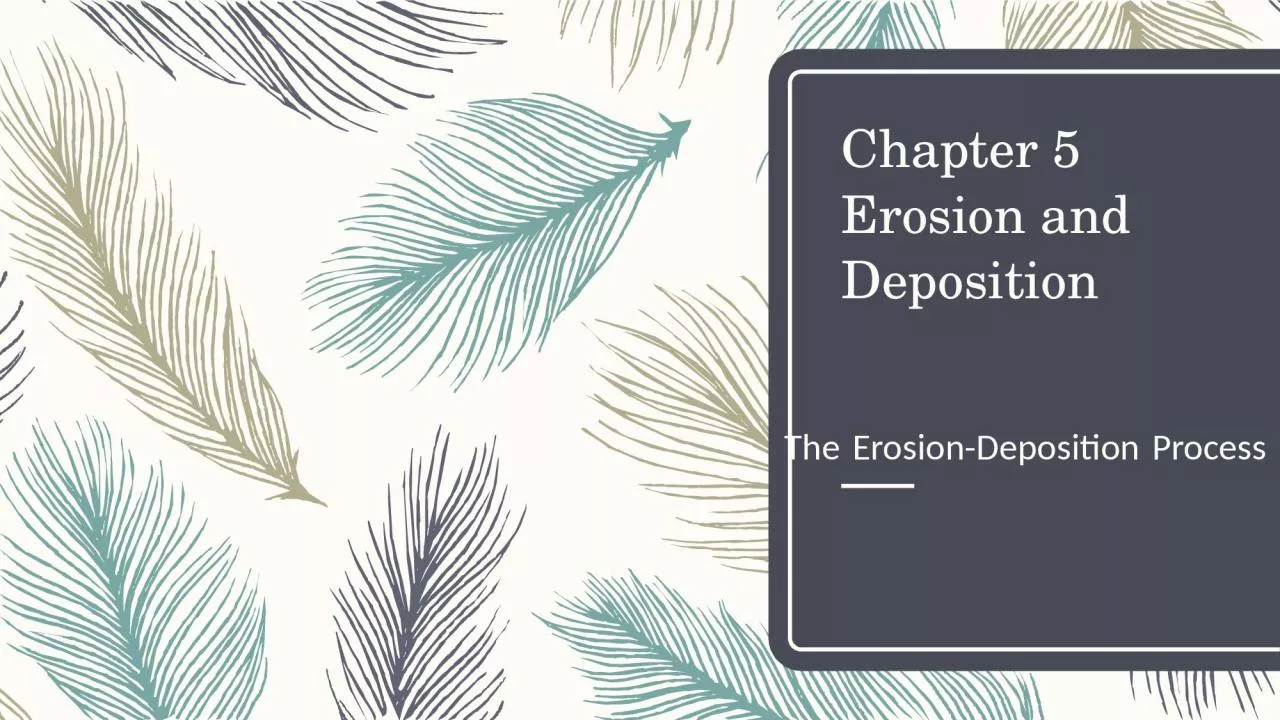

The ErosionDeposition Process Constructive vs Destructive Constructive process build up features on Earths surface Lave erupting from a volcano hardens and forms new land on the area where lava falls ID: 1047172
Download Presentation The PPT/PDF document "Chapter 5 Erosion and Deposition" is the property of its rightful owner. Permission is granted to download and print the materials on this web site for personal, non-commercial use only, and to display it on your personal computer provided you do not modify the materials and that you retain all copyright notices contained in the materials. By downloading content from our website, you accept the terms of this agreement.
1. Chapter 5Erosion and DepositionThe Erosion-Deposition Process
2. Constructive vs. DestructiveConstructive process build up features on Earth’s surfaceLave erupting from a volcano hardens and forms new land on the area where lava falls.Destructive process tear down features on Earth’s surfaceHurricane can wash part of a shoreline into the sea
3. Weathering The breakdown of rock. Chemical weathering which changes the mineral composition of rockMechanical (Physical) weathering breaks rock into smaller pieces without changing the compositionIs a destructive processWeathering Agents-water, wind, and iceWater can dissolve minerals in rocksWind can grind and polish rocks by blowing particles against themIce can break a rock apart as it expands
4. ErosionThe removal of weathered material from one location to another.Agents of erosion-water, wind, glaciers, gravity
5. The Rate of ErosionFactors that affect the rate of erosion include weather, climate, topo-graphy, and type of rockStrong winds transport weathered rock more easily than gentle breezeWeathered rock moves faster down a steep hill than a flat areaErosion occurs faster on barren land than on land covered with vegitationRate of erosion sometimes depends on the type of rock Weathering can break rocks into small or large pieces depending on the type of rock
6. SortingErosion affects level of sortingThe separating of items into groups according to one or more propertiesPoorly sorted sediment, moderately sorted sediment, well-sorted sediment
7. DepositionConstructive ProcessIs the laying down or settling of eroded material
8. Depositional EnvironmentSediments deposited in locations on land, along coast, or in other oceansSwamps, deltas, beaches, barrier island, marshes, and the ocean floorEnvironment where sediment is transported and depositedHigh-energy environments (rushing rivers, ocean shores with large waves, and deserts with strong winds)Low-energy environments (deep lakes and areas of slow-moving air or water)
9. LandformsMountains, valleys, plains, sea cliffs, and beachesCharacteristics-structure, elevation, and rock exposureCan be observed to determine whether destructive forces (erosion), constructive forces (deposition) produced landforms
10. Landforms Created by ErosionLandforms can have features that are produced by erosion (often tall, jagged structure with cuts in layers of rock)Landforms formed by erosion can expose several layers of rockDifferent rates of erosion can result in unusual landforms when some rocks erode and leave more erosion-resistant rocks behindGlacial erosion and coastal erosion form unique landforms
11. Landforms Created by DepositionLandforms created by deposition are often flat and low-lyingWind deposition form deserts of sandDeposition also occurs where mountain streams reach the gentle slopes of wide, flat valleysAlluvial Fan-an apron of sediment forms where a stream flows from a steep, narrow canyon onto a flat plain at the foot of a mountain
12. Landforms Created by Deposition cont’dWater traveling in a river can slow due to friction with the edges and the bottom of the river channelDeposition can form sandbarEndpoint for most rivers in where they reach a lake or an ocean and deposit sediment Wave action at a shoreline moves and deposit sediment